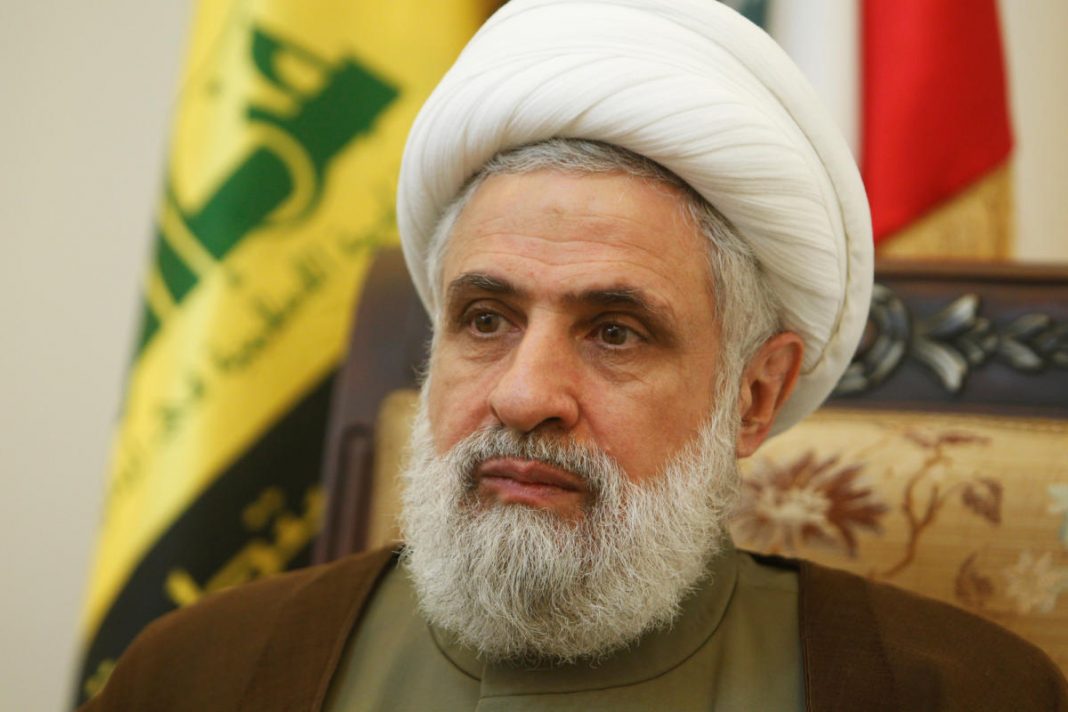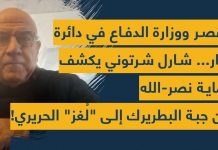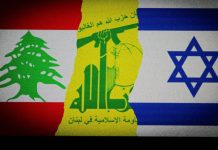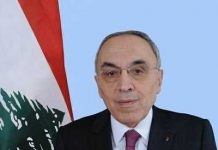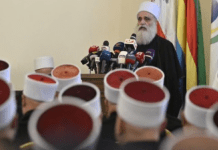Having Tea with Hezbollah’s No. 2
Robin Wright/The New Yorker/December 13/16
Naim Qassem is the second-in-command of Hezbollah, the Shiite organization based in Lebanon and backed by Iran, which has supported Bashar al-Assad in Syria’s civil war.
Across Lebanon, Hezbollah runs special cemeteries—some with their own Facebook pages—for its fighters. I recently visited several of them, including the new Garden of Zeinab, named after the Prophet Muhammad’s granddaughter, where I counted a hundred and fifteen recent graves. Each was covered with a long white marble slab that detailed the fighter’s life; the headstone showed a large color photograph. Khodor Safa, nineteen, was in the front row. He died in September, “performing his jihadi duties,” the grave said. His slab was decorated with three votive candles, artificial white flowers, and a small Koran. Nearby, a large balloon offering “Congratulations”—for martyrdom—was attached to the grave of Ali Hussein Wehbi. Several families tended to other gravestones, dusting them off, laying flowers, or sitting alongside them in plastic chairs made available to visitors.
Some two thousand Hezbollah fighters have died and at least six thousand have been wounded since 2012, when the Shiite movement intervened in Syria’s civil war, on behalf of President Bashar al-Assad. That’s a staggering proportion, given the size of its deployment: Hezbollah keeps about five thousand fighters in Syria, with another three thousand deployed as needed, according to Lebanese officials and sources close to Hezbollah. Losses have been especially heavy since last summer, when the battle for Aleppo, once Syria’s commercial hub and largest city, escalated. Hezbollah had to recruit hard to replenish its ranks. The scuttlebutt in Beirut is that standards have been lowered, training expedited, and religious indoctrination made less rigorous.
Naim Qassem, a cleric who wears a white turban and has a trim beard to match, is Hezbollah’s second-in-command. From Hezbollah’s public-relations office, two fighters drove me, in a black Chevrolet S.U.V. with draperies on the windows, to meet Qassem in Beirut’s poor southern suburbs, the movement’s stronghold. The flags of Hezbollah and Lebanon were in a corner of the meeting room; a plate of dates and almonds was on a table. Attendants brought in rotating trays of tea, juice, and water as we talked. I asked Qassem if the intervention was worth the increasing costs, human and political.
“Since in the West you like to use metaphors and examples, I will give you one,” he said. “You have a house, and in this house there is a fighter, his wife, and children, and there is an enemy attacking this house. You have a garden and a wall, and a hundred metres away you have an olive grove. Is it better to protect the olive trees or the house? Near the olive grove the fighter will die. But if they get to the house, the house will be destroyed and everyone will die. We went to Syria, near the olive trees.” Qassem added, “We believe that as important as the losses or the sacrifices in Syria are, they are much less than if Syria had disintegrated.”
Founded, trained, and armed by Iran after Israel’s 1982 invasion of Lebanon, Hezbollah has been transformed by three tactical decisions. Each has been a progressively bolder gamble; with each, Hezbollah’s impact has grown, even as the costs have soared and its popularity has fluctuated.
In 1993, the then clandestine movement—linked to a decade of terrorist attacks and hostage seizures—emerged from the underground to declare itself a political party and run for parliament. It is now the most determined political actor among the many parties who represent Lebanon’s eighteen recognized sects. For more than two years, Lebanon had no President—a position reserved for Maronite Christians—because of political paralysis in parliament. In October, Hezbollah’s candidate, Michel Aoun, a former general who has been allied with Hezbollah for a decade, finally won.
Hezbollah has developed parallel public institutions, too. It is second only to the national government in providing social services, including health care, in Lebanon. One of its largest hospitals, a cardiac-care center, is on Beirut’s main boulevard to the airport. It runs schools, welfare programs, and a sophisticated broadcast and media operation.
The second shift was in 2006, when Hezbollah’s raid across the Israeli border—to kidnap Israeli soldiers as bargaining chips to win freedom for allies in Israeli jails—provoked the longest modern Arab-Israeli war. It was massively destructive, particularly in Shiite areas. But it resulted in a strategic draw, a first in modern Middle East conflicts.
“This put us in hearts around the Arab world,” Qassem told me. “There was a conviction that Hezbollah was capable of other victories.” By 2008, Hezbollah’s chief, Hassan Nasrallah, was rated the most popular leader in the Arab world, even among Sunni Muslims, according to a poll by the University of Maryland’s Sadat Center for Peace and Development.
Today, Hezbollah is the largest “resistance” force in the Arab world, even though it is not a state and much of the Arab world has branded it a terrorist group. Its army has steadily increased; it has some twenty thousand regular forces, and more than twice that number if it calls up reserves. It has at least as many troops deployed in south Lebanon, on the Israeli front, as in Syria.
The Hezbollah arsenal of rockets and missiles is seven times larger than it was during the war with Israel a decade ago, the Israeli Ambassador Danny Danon told the U.N. Security Council last summer. Hezbollah has “more missiles below ground in Lebanon than the European NATO allies have above ground,” he said. The most powerful have a range that could hit Tel Aviv and Eilat, Israel’s southernmost city, and a port and resort town. Last month, the Washington Post reported that Hezbollah has obtained American war materiel, including M113 classic armored personnel carriers. Hezbollah no longer trains totally in secret. Its training camps and urban-warfare centers in the eastern Bekaa Valley are visible by satellite. It even has its own fleet of surveillance drones, hundreds strong, some armed with explosives.
The third tactical decision, in 2012, was to join Syria’s civil war, partly to protect the transit route for weapons from Iran, through Syria, into Lebanon. “Syria plays a big role in supporting the resistance politically and militarily,” Qassem told me. “So we had two choices: either Syria remains a supporter of the resistance, or we would have on the eastern border a country that is against Lebanon and the resistance, and to the south Israel. Therefore, by Syria not falling apart, we insure an open road for the continuation of the resistance.”
Assad almost certainly would not have held onto power without Hezbollah troops on the ground, Russian airpower, and military aid from Iran’s Revolutionary Guards (who have also suffered hundreds of dead). Assad’s own military is battered and diminished after six years of war. Hezbollah has fought on some of the toughest fronts, including the current battle for Aleppo. It may have made the strategic difference. “There are great events taking place now in our region,” Nasrallah said in a speech on Friday, broadcast on Hezbollah’s television station Al Manar. He referred to “what is happening in Aleppo, and the ramifications of the promised and coming victory for the whole battle in Syria and the region.”
Hezbollah’s deployment in Syria now makes it one of the most combat-hardened militaries in the Middle East. “In the eyes of the people, the political powers, the countries—whether friends or foes—we are an actual regional power,” Qassem said, “because our positions have regional consequences.”
Hezbollah’s growing profile has deepened the region’s sectarian divide. Within a year of dispatching troops to Syria, its standing plummeted, especially among Sunnis. Hezbollah means “Party of God” in Arabic. Among Sunnis, it’s been dubbed Hizbu Shaitan, or “Party of the Devil.” It also remains a tool of Iran, more than three decades after it was created, and is still heavily dependent on Tehran’s financial largesse. “We are open about the fact that Hezbollah’s budget, its income, its expenses, everything it eats and drinks, its weapons and rockets, come from the Islamic Republic of Iran,” Nasrallah said, with unusual candor, in a speech in June. “As long as Iran has money, we have money.”
The United States estimates that the Islamic Republic has provided Hezbollah up to two hundred million dollars a year, although international sanctions forced Tehran to cut back aid in 2014 and 2015. “The group is in its worst financial shape in decades,” Adam Szubin, the Treasury Department’s acting undersecretary for terrorism and financial intelligence, told the Senate Banking Committee in May. “And I can assure you that, alongside our international partners, we are working hard to put them out of business.” Hezbollah reportedly has been forced to scale back staff and social services.
Despite the death toll, Hezbollah’s ambitions continue to grow. It is “ready” to help others in the region “who wish to be liberation movements,” Qassem told me. The militia has generated an affiliate in Syria. “If we have five Hezbollah fighters from Lebanon, they are running twenty-five others in Syria who have not necessarily come from Lebanon,” he claimed. Hezbollah is also aiding Shiites in Iraq and Houthis in Yemen. It is prepared, the sixty-three-year-old cleric told me, to assist “anyplace where there is a cause we believe in and are needed.”
**Robin Wright is a contributing writer for newyorker.com, and has written for the magazine since 1988.
















